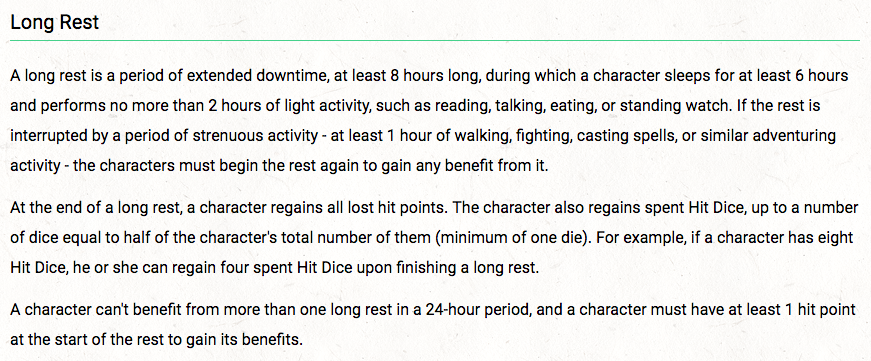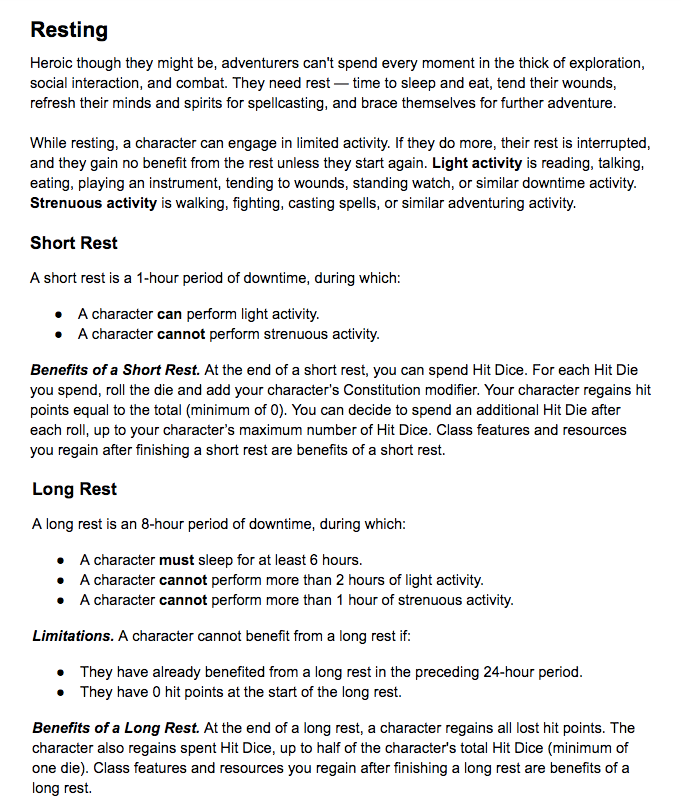While we pride ourselves on deeper analytics, there’s no reason you should have to work to understand the basic game mechanics. With that in mind, we’ve turned our eye towards refining some of the simpler mechanics in Dungeons & Dragons 5th Edition in a new series called The Simple Things. To be clear, while this series will involve rewriting various rules, the intent is to preserve the identical function of the Rules as Written (“RAW”). Without further ado, let’s dive into our first topic: resting.
Resting
Why rewrite the resting mechanics? In my experience, the finer points of resting often get lost in translation. The way it’s written, two things often get missed:
- You can only take one long rest per 24 hours.
- You only recover half your Hit Dice on a long rest.
A lot of experienced players don’t even realize they’re playing without these rules.
These are important because they form the foundation that the entire game’s encounter system is built on. What am I talking about? The infamous and oft misunderstood “six to eight medium encounters per rest” paradigm. Unless you’re running the Agnostic Adventuring Day, missing out on these rules means that you are undermining the core balance of the system by permitting resting too often and giving your players back too many resources when they do.
Over the course of time, the resting mechanic has also been the subject of errata intended to clarify what “activities” could be performed during a long rest. But, the language still leaves some debate regarding what amount of activity can be performed during the non-sleeping time of a long rest. There are also some questions about how this interplays with the elves’ Trance racial feature, which has been the subject of Sage Advice and changing treatment through 5e’s history.
How to Fix It
The resting rules as written are needlessly complicated:



Outside the fluff, there’s really only two things you need to know about rests:
- What you need to do to qualify.
- What you get when you finish.
In order to tell you how to qualify, we can define the “activity” terms which are suggested to exist, but are not specifically defined. Then we can lean on those defined terms to tell the players what they can do and what they can’t do. In this case, we’ll define the types of activities you can do by borrowing terms from the text: light activity and strenuous activity. Then, we’ll state very clearly how much of each activity you can and cannot do during each type of rest.
Finally, while I initially didn’t think this necessary, D&D designer Dan Dillon turned me on to the fact that a lot of pedantic table arguments can be avoided with a simple rider explaining that “class features and resources you gain at the end of a [short/long] rest are benefits of a [short/long] rest.” Thanks Dan!
Packing all that in, here’s the revised resting rules:

You can find the full text of the image above for free on the ThinkDM Patreon. If you enjoyed this content, please consider supporting the site so we can bring you more!
I’m unsure about “A character cannot perform more than 1 hour of strenuous activity.” Is the period of strenuous activity part of the 8 hour rest, or does it count as non-resting time that needs to be made up for my extended the rest by the same amount? The exact wording in the PHB is, “If the rest is INTERRUPTED by a period of strenuous activity…” which makes me think it’s the latter.
LikeLike
The word “interrupted” causes some false inferences. This is all stuff that happens within an 8 hour time period. The only mechanic that’s tied to the “interruption” is that if it goes over an hour, the long rest ends.
Here’s the lead rule designer confirming this interpretation:
Crawford on Combat: https://twitter.com/JeremyECrawford/status/764150520646742016
Crawford on Casting: https://twitter.com/JeremyECrawford/status/646383855964852224
LikeLike
I’m unsure about “A character cannot perform more than 1 hour of strenuous activity.” Is the period of strenuous activity part of the 8 hour rest, or does it count as non-resting time that needs to be made up for my extended the rest by the same amount? The exact wording in the PHB is, “If the rest is INTERRUPTED by a period of strenuous activity…” which makes me think it’s the latter.
LikeLike
It’s part of the rest!
LikeLike
I just can’t understand the notion that you get all your head points back after a long rest.
I’ve heard myself pretty bad many times. falling off a ladder, a couple car crashes, various fights, cut cut a bit of my finger off with an axe, crushed another finger between two logs, fell off of a small cliff, and others.
A night’s rest does help, but I am not back to full strength after a single night of rest. A real wound takes days, sometimes longer, to heal.
I think I’m much better mechanic would be to allow the character to heal up half of whatever missing hit points they have per long rest, minimum of one hit point.
Similarly a short rest needs to be nerfed a little bit. If you can spend all of your hit dice on a short rest, that means a character could potentially be down to one hit point, rest for an hour, and be all the way back up to full. That seems wildly overpowered.
LikeLike
Hi Aaron! As you know, these are just the RAW rules rewritten. I’m not opining on their strength as a system. Personally, I feel that the viability of resting depends a lot on the flavor and cadence of the campaign. That makes it kind of hard to make a resting hack that works for every table. Some folks really like gritty realism rule from the DMG, which sounds like it would be up your alley!
LikeLike
Agreed, the designers did not think these ruled through and the DMG variant rules are not much better.
LikeLike
This is how it was in earlier versions of D&D. It was changed because it slowed the pace of gameplay too much.
LikeLike
I should have checked my text before posting. Apologies.
I just can’t understand the notion that you get all your hit points back after a long rest.
I’ve hurt myself pretty bad many times. Falling off a ladder, a couple car crashes, various fights, cut a bit of my finger off with an axe, crushed another finger between two logs, fell off of a small cliff, and others.
A night’s rest does help, but I am not back to full strength after a single night of rest. A real wound takes days, sometimes longer, to heal.
I think a much better mechanic would be to allow the character to heal up half of whatever missing hit points they have per long rest, minimum of one hit point.
Similarly a short rest needs to be nerfed a little bit. If you can spend all of your hit dice on a short rest, that means a character could potentially be down to one hit point, rest for an hour, and be all the way back up to full. That seems wildly overpowered.
LikeLike
RAW, a character is allowed to cast spells and fight for up to an hour per long rest. I think that part was missed in your definition of light activity
LikeLike
I came up with a homerule I like regarding rests: if you rest in your armor you gain half as much Hit Dice as you would otherwise (minimum of 1).
LikeLike
I like the homebrew rule I came up with for adventurers too scared to remove their armor during a rest (for fear they might be attacked and not have 10 minutes to don heavy armor):
You gain half as many Hit Dice as you normally would if you wear armor while resting (minimum of 1).
LikeLike
That is the rule and/or has been the rule for years. This rule is based on and written in the equipment section and this is by no means a home brew rule, you’re just enforcing the rule.
LikeLike
These revised resting rules are clear and concise, but they don’t appear to cover “how this interplays with the elves’ Trance racial feature”.
LikeLike
The way D&D rules are constructed, there are general rules and specific rules. This is the general rule on resting. The specific rule on the elves’ Trance specifies that they do not need to sleep. D&D doesn’t build exceptions for specific rules into general rules, because then you get a system that’s really kludgy and redundant.
LikeLiked by 1 person
Sure, but you mentioned in the article that “[t]here are also some questions about how this interplays with the elves’ Trance racial feature,” so it seems odd not to address those questions in your rewriting of the rules for clarity. Could you not have an additional section at the end covering Trance?
LikeLike
Reblogged this on DDOCentral.
LikeLike